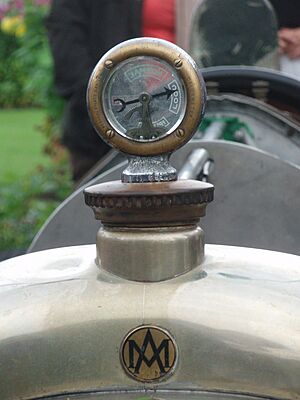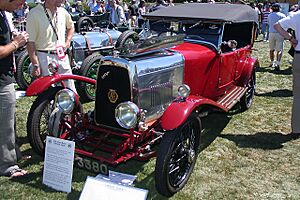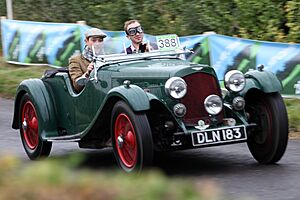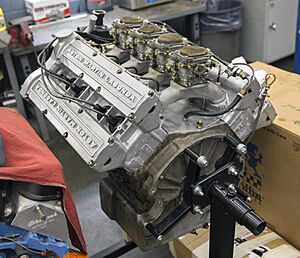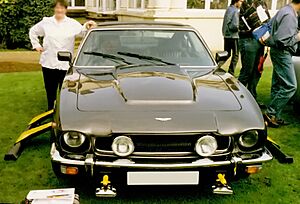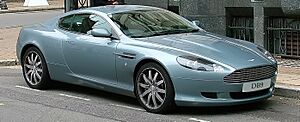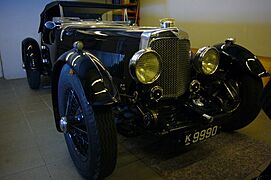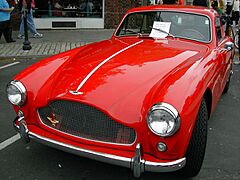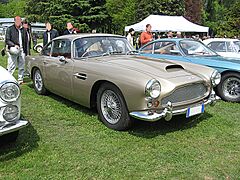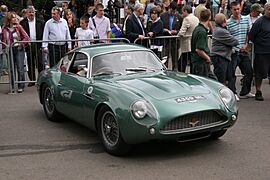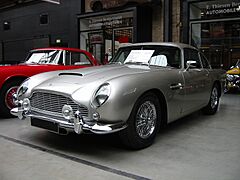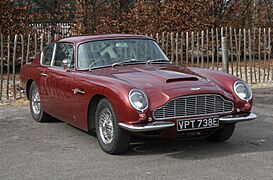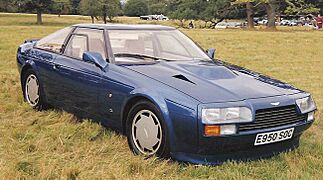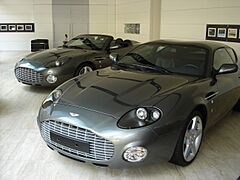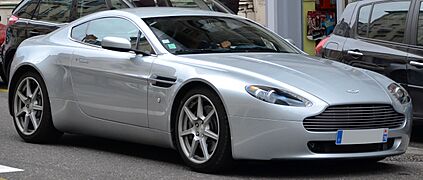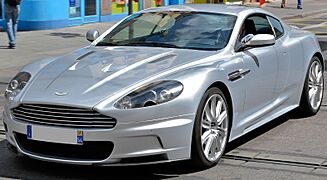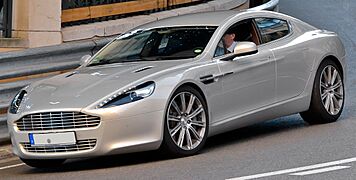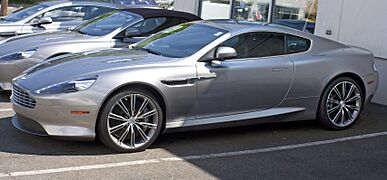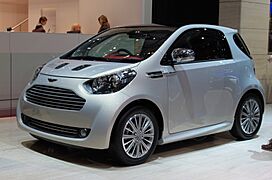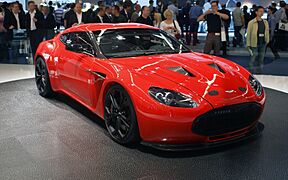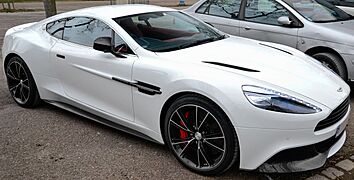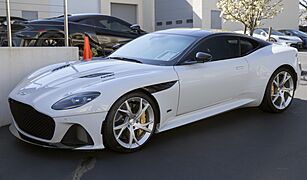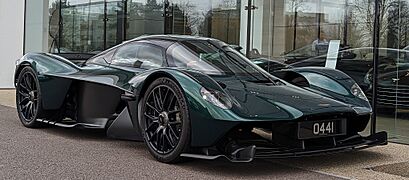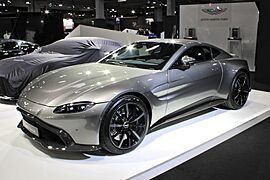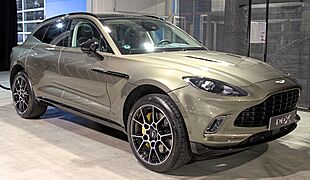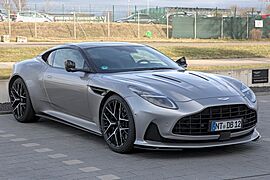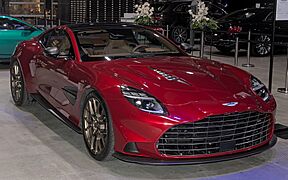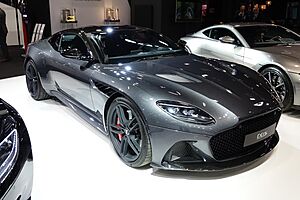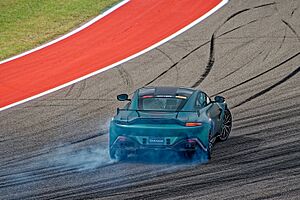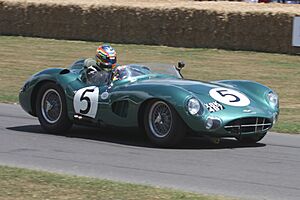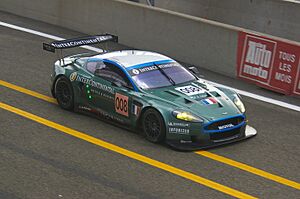Aston Martin facts for kids
 |
|
|
Formerly
|
Aston Martin Lagonda Global Holdings Limited (July–September 2018) |
|---|---|
| Public limited company | |
| Traded as | LSE: AML FTSE 250 component |
| Industry | Automotive |
| Founded | 15 January 1913 |
| Founders |
|
| Headquarters | Gaydon, Warwickshire, England, United Kingdom |
|
Area served
|
Worldwide |
|
Key people
|
|
| Products |
|
| Brands |
|
| Revenue | |
|
Operating income
|
|
| Subsidiaries | Aston Martin Racing |
Aston Martin Lagonda Global Holdings PLC is a British company that makes fancy luxury sports cars. It also makes powerful cars called grand tourers. The company started way back in 1913. It was founded by two friends, Lionel Martin and Robert Bamford.
Aston Martin cars became super famous in the 1950s and 1960s. This was especially true after the spy character James Bond drove an DB5 in the 1964 movie Goldfinger. Many people now see Aston Martin cars as a symbol of British culture.
Aston Martin has a special "royal warrant" from King Charles III since 1982. This means they are official car suppliers to the royal family. The company sells cars in over 50 countries. This makes it a truly global car brand. Aston Martin is listed on the London Stock Exchange. It even won the Queen's Award for Enterprise in 2003 for its international trade. The company has faced tough times, going bankrupt seven times in its history.
The main factory for sports cars and grand tourers is in Gaydon, England. It's a huge 55-acre site. Another old factory in Newport Pagnell now focuses on classic car sales and repairs. A newer 90-acre factory in St Athan, Wales, builds Aston Martin's SUV model, the DBX.
Aston Martin has also been involved in car racing. They mainly race in sports car racing and Formula One. The Aston Martin name is also used for other luxury items. These include a submarine, fancy homes, and even aircraft.
Contents
The Story of Aston Martin
How it All Started
Aston Martin was created in 1913 by Lionel Martin and Robert Bamford. Before that, they sold and fixed cars from a small shop in London. Lionel Martin loved racing cars at Aston Hill. This inspired them to build their own cars. The very first car named Aston Martin was made by Martin in 1915. He put a special engine into an old car frame.
However, they couldn't start making many cars because of the First World War. Both founders joined the army during this time.
Growing Up: The Years Between Wars
After the war, they moved to a new place and designed a new car. Robert Bamford left the company in 1920. The company got new money from Louis Zborowski. In 1922, Aston Martin cars raced in the French Grand Prix. They even set world speed records!
About 55 cars were sold during this time. But the company ran into money problems again in 1924. It was bought by Lady Charnwood. Then, in 1925, Lionel Martin had to sell the company too.
Later that year, Bill Renwick and Augustus (Bert) Bertelli took over. They renamed it Aston Martin Motors. Bertelli became the main designer for all new Aston Martins until 1937. These cars were known as "Bertelli cars." Most were open sports cars. Bertelli himself was a good driver and raced his own cars.
More money problems came up in 1932. Sir Arthur Sutherland saved the company in 1932. By 1936, Aston Martin decided to focus on making cars for the road. They built about 700 cars before World War II stopped production. During the war, they made parts for airplanes instead.
The David Brown Era: Famous "DB" Cars
In 1947, a company called David Brown Limited bought Aston Martin. This was a big turning point. David Brown also bought another car company, Lagonda. Lagonda had a great engine designed by W. O. Bentley. Both companies then shared engines and workshops. This is when Aston Martin started making its famous "DB" series of cars.
The DB2 came out in 1950. Then came the DB2/4 in 1953, and the DB Mark III in 1957. In 1958, the stylish DB4 was released.
These cars helped Aston Martin become known for racing. The DB4 was especially important. It led to the creation of the legendary DB5 in 1963. Aston Martin continued making luxury grand touring cars like the DB6 (1965–70) and DBS (1967–1972).
New Owners and Modern Cars
Aston Martin often struggled financially. In 1972, David Brown sold the company. It was bought by a group of investors. They faced a worldwide economic slowdown. This made it hard to sell cars, especially in the US due to new pollution rules. The factory closed in late 1974.
In 1975, new owners took over. They were Peter Sprague, George Minden, and Alan Curtis. They reopened the factory with 100 employees. The new owners wanted to make Aston Martin cars more modern. They introduced the V8 Vantage in 1977. They also made the Volante convertible in 1978. A very unique car called the Bulldog was designed in 1980. The futuristic Lagonda sedan also came out.
The Victor Gauntlett Years
In 1981, Victor Gauntlett bought Aston Martin. He became the boss. He helped sell the Lagonda car in the Middle East. In 1982, Aston Martin received a special award from the Prince of Wales.
To help the company, they started a new business. It developed car parts for other companies. They used the name Tickford, which was an old coachbuilder Aston Martin had bought. Tickford made special versions of cars like the Austin Metro and Ford Capri.
Sales of Aston Martin cars were very low in 1982. Gauntlett sold his share to Peter Livanos, a Greek shipping businessman. Gauntlett stayed as chairman. In 1984, Aston Martin built its 10,000th car!
Gauntlett also helped bring James Bond back to Aston Martin. For the 1986 movie The Living Daylights, Gauntlett lent his own car for filming.
Ford Takes Over
In 1987, Ford bought most of Aston Martin. They later bought the rest of the company. In 1988, Aston Martin released the new Virage range. This replaced the older V8 models.
Ford invested a lot of money into Aston Martin. They built a new factory in Bloxham in 1994 to make the DB7. By 1995, Aston Martin made a record 700 cars. Before Ford, cars were mostly built by hand.
The DB7 was very popular. In 2002, the 6,000th DB7 was built. This was more than all previous DB models combined! In 1999, more powerful V12 versions of the DB7 came out. In 2001, the top-of-the-line Vanquish was introduced.
In 2003, Aston Martin showed the V8 Vantage concept car. This car brought back the classic V8 engine. Also in 2003, the Gaydon factory opened. This was the first factory built just for Aston Martin. The DB9 coupé also came out in 2003, replacing the DB7. A convertible version, the DB9 Volante, followed in 2004.
In 2004, Aston Martin opened a special engine plant in Germany. It could make up to 5,000 engines a year. Each engine was built by one skilled person. This allowed Aston Martin to make special, high-performance engines.
In 2003, Aston Martin announced it would return to racing in 2005. A new team, Aston Martin Racing, was created. They designed and managed the DBR9 racing car. The DBR9 competed in famous races like the 24 Hours of Le Mans.
In 2006, Ford decided to sell parts of its luxury car group. They announced they would sell Aston Martin.
A New Chapter: Private Ownership
On March 12, 2007, a group led by Prodrive chairman David Richards bought Aston Martin. Ford kept a small share.
To show how tough the V8 Vantage was, two Britons drove it from Tokyo to Istanbul in 2007. This helped Aston Martin open new dealerships in China.
On July 19, 2007, the Newport Pagnell factory built its last car. This factory had made almost 13,000 cars since 1955. Now, it focuses on classic car services. All new car production moved to the Gaydon factory. In 2008, Aston Martin announced they would bring back the Lagonda car brand.
Due to a global economic slowdown, Aston Martin cut its workforce in December 2008.
The four-door Rapide grand tourer started being built in Austria in 2010. But in 2011, production of the Rapide moved back to Gaydon. This brought all car manufacturing back to one place.
In December 2012, an Italian investment fund bought a large share in Aston Martin. David Richards left the company in 2013. In 2014, Andy Palmer became the new CEO. Aston Martin's sales had been going down. Palmer planned to create new car models and work with other companies. He said, "In the first century we went bankrupt seven times. The second century is about making sure that is not the case."
Aston Martin invested money to expand its factory in Gaydon. They added new buildings for chassis and car assembly. In 2014, Aston Martin lost money. They also needed more money from their owners to develop new models. In 2016, they continued to lose money.
In February 2016, the company chose a 90-acre site in St Athan, South Wales for a new factory. This factory was built in old airplane hangars. Construction started in April 2017. Aston Martin made a profit again in 2017 after selling over 5,000 cars.
Working with Mercedes-Benz
In December 2013, Aston Martin made a deal with Mercedes-Benz Group. Mercedes-Benz would supply engines and electrical systems for future Aston Martin cars. In return, Mercedes got a small share in Aston Martin. The first car to use Mercedes-Benz technology was the DB11 in 2016. It used Mercedes-Benz electronics and V8 engines. In October 2020, Mercedes said it would increase its share in Aston Martin. This would give Aston Martin access to Mercedes-Benz hybrid and electric car technology.
Going Public and Recent Changes
After making a profit, Aston Martin announced plans to sell shares on the London Stock Exchange in August 2018. The company officially became "Aston Martin Lagonda Global Holdings plc" on October 3, 2018. In June 2019, the new 90-acre factory in St Athan opened. It started making the DBX SUV.
On January 31, 2020, Canadian billionaire Lawrence Stroll led a group that invested a lot of money in Aston Martin. Stroll became the new chairman. Other investors, including Ernesto Bertarelli and Toto Wolff, also joined. In March 2020, Stroll increased his share in the company.
On May 26, 2020, Andy Palmer stepped down as CEO. Tobias Moers from Mercedes-AMG took over on August 1, 2020. In June 2020, Aston Martin cut 500 jobs due to lower sales during the COVID-19 pandemic. In March 2021, Lawrence Stroll said the company plans to build electric vehicles by 2025. In May 2022, Amedeo Felisa became the new CEO.
In late 2020, Aston Martin was involved in a discussion about electric vehicles. A report was published that compared the environmental impact of different car types. It suggested electric cars needed to be driven a very long distance to be cleaner than petrol cars. However, experts disagreed with this report's findings.
In July 2022, Saudi Arabia's Public Investment Fund invested in Aston Martin. This gave them a 16.7% share and two seats on the board. In September 2022, Chinese carmaker Geely also bought a 7.6% share. By May 2023, Geely increased its share to 17%.
In June 2023, Aston Martin partnered with Lucid Motors. Lucid will supply electric motors and battery systems for Aston Martin's future electric cars. In return, Aston Martin gave Lucid a small share in its company. In October 2023, Aston Martin announced it would compete in the FIA World Endurance Championship and IMSA SportsCar Championship in 2025. In April 2024, the company said it would delay its first electric vehicle until 2027. In March 2024, Adrian Hallmark was announced as the new CEO, starting October 1, 2024.
In September 2024, Aston Martin warned about lower profits due to less demand in China. In November 2024, they issued another warning about delays in their Valiant model. They announced plans to raise more money by selling new shares. In February 2025, CEO Adrian Hallmark said the first electric vehicle production would be pushed back to 2030. On March 31, 2025, the Yew Tree Consortium planned to invest more money, increasing their share to 33%. The company also plans to sell shares in its Formula One racing team.
Amazing Auction Sales
In August 2017, a 1956 Aston Martin DBR1 racing car sold for over $22.5 million at an auction. This made it the most expensive British car ever sold at auction at that time. Famous drivers like Carroll Shelby and Stirling Moss had driven this car.
Other Aston Martins have also sold for huge amounts. A 1962 Aston Martin DB4 GT Zagato sold for $14.3 million in 2015. A 1963 Aston Martin DP215 sold for over $21.4 million in August 2018.
Aston Martin Car Models
Cars Before World War II
- 1921–1925 Aston Martin Standard Sports
- 1927–1932 Aston Martin First Series
- 1929–1932 Aston Martin International
- 1932–1932 Aston Martin International Le Mans
- 1932–1934 Aston Martin Le Mans
- 1933–1934 Aston Martin 12/50 Standard
- 1934–1936 Aston Martin Mk II
- 1934–1936 Aston Martin Ulster
- 1936–1940 Aston Martin 2-litre Speed Models
- 1937–1939 Aston Martin 15/98
Cars After World War II
- 1948–1950 Aston Martin 2-Litre Sports (DB1)
- 1950–1953 Aston Martin DB2
- 1953–1957 Aston Martin DB2/4
- 1957–1959 Aston Martin DB Mark III
- 1958–1963 Aston Martin DB4
- 1961–1963 Aston Martin DB4 GT Zagato
- 1963–1965 Aston Martin DB5
- 1965–1966 Aston Martin Short Chassis Volante
- 1965–1969 Aston Martin DB6
- 1967–1972 Aston Martin DBS
- 1969–1989 Aston Martin V8
- 1977–1989 Aston Martin V8 Vantage
- 1986–1990 Aston Martin V8 Zagato
- 1989–1996 Aston Martin Virage
- 1989–2000 Aston Martin Virage
- 1993–2000 Aston Martin Vantage
- 1996–2000 Aston Martin V8 Coupe/V8 Volante
- 1993–2003 Aston Martin DB7
- 2001–2007 Aston Martin Vanquish
- 2002–2003 Aston Martin DB7 Zagato
- 2002–2004 Aston Martin DB AR1
- 2004–2016 Aston Martin DB9
- 2005–2018 Aston Martin V8 and V12 Vantage
- 2007–2012 Aston Martin DBS
- 2009–2012 Aston Martin One-77
- 2010–2020 Aston Martin Rapide
- 2011–2012 Aston Martin Virage
- 2011–2013 Aston Martin Cygnet
- 2012–2018 Aston Martin Vanquish
- 2015–2016 Aston Martin Vulcan
- 2016–2023 Aston Martin DB11
- 2018–2024 Aston Martin DBS Superleggera
- 2021–2024 Aston Martin Valkyrie
- 2018–present Aston Martin Vantage
- 2020–present Aston Martin DBX
- 2023–present Aston Martin DB12
- 2024–present Aston Martin Vanquish
Other Special Models
- 1944 Aston Martin Atom (concept car)
- 1961–1964 Lagonda Rapide
- 1976–1989 Aston Martin Lagonda
- 1980 Aston Martin Bulldog (concept car)
- 1993 Lagonda Vignale (concept car)
- 2001 Aston Martin Twenty Twenty (concept car)
- 2007 Aston Martin V12 Vantage RS (concept car)
- 2009 Aston Martin Lagonda SUV (concept car)
- 2011–2013 Aston Martin V12 Zagato
- 2013 Aston Martin Rapide Bertone Jet 2+2 (concept car)
- 2013 Aston Martin CC100 Speedster (concept car)
- 2015 Aston Martin DB10 (concept car)
- 2015–2016 Lagonda Taraf
- 2019 Aston Martin Lagonda All-Terrain (concept car)
- 2019 Aston Martin Vanquish Vision (concept car)
- 2019 Aston Martin DBS GT Zagato
- 2020 Aston Martin V12 Speedster
- 2021 Aston Martin Victor
- 2022 Aston Martin DBR22
- 2023 Aston Martin Valour
- 2024 Aston Martin Valiant
Current Models You Can Buy
- Aston Martin Vantage
- Aston Martin DB12
- Aston Martin Vanquish
- Aston Martin DBX
Upcoming Models
- Aston Martin Valhalla
Gallery
- Aston Martin models
Beyond Cars: Brand Expansion
Since 2015, Aston Martin has tried to appeal to more people, including women. They want to be seen as a luxury lifestyle brand. They even created a special panel to help design cars that women would like.
Aston Martin has also put its name on other cool products:
- In 2016, they showed off a 37-foot-long speedboat called the Aston Martin AM37.
- In 2018, they launched a small submarine called Project Neptune. They worked with a company called Triton Submarines.
- They have teamed up with luxury clothing companies like Hackett London.
- In 2017, they released a special limited edition bicycle with Storck.
- Aston Martin also worked with a property developer to build a 66-story luxury apartment building in Miami, Florida. It opened in 2024.
- In 2018, they unveiled a concept aircraft called the Volante Vision Concept. It can take off and land vertically.
- A Lego version of James Bond's DB5 car went on sale in 2018.
- They also released an Aston Martin-branded watch with TAG Heuer.
- In October 2018, Aston Martin opened a design studio in Shanghai, China.
Racing with Aston Martin
Aston Martin is involved with two main racing teams. The Aston Martin Formula One team races in the Formula One Championship. Aston Martin Racing competes in the FIA World Endurance Championship. While both use the Aston Martin name, they are not directly owned by the car company itself. The Formula One team is owned by a major Aston Martin shareholder, Lawrence Stroll. Aston Martin Racing is run by a company called Prodrive.
Formula One History
Aston Martin first raced in Formula One in 1959 and 1960. They didn't score any points back then. In January 2020, it was announced that the Racing Point F1 Team would change its name to Aston Martin for the 2021 season. This happened because Lawrence Stroll, who owns Racing Point, invested in Aston Martin. The team changed its racing color to a modern version of Aston Martin's British racing green. The Aston Martin AMR21 was shown in March 2021. It was Aston Martin's first Formula One car in 61 years!
Post-War Racing Cars
- Aston Martin DB3 (1950–1953)
- Aston Martin DB3S (1953–1956)
- Aston Martin DBR1 (1956–1959)
- Aston Martin DBR2 (1957–1958)
- Aston Martin DBR3 (1958)
- Aston Martin DBR4 (1959)
- Aston Martin DBR5 (1960)
- Aston Martin DP212 (1962)
- Aston Martin DP214 (1963)
- Aston Martin DP215 (1963)
- Aston Martin RHAM/1 (1976–1979)
- Aston Martin AMR1 (1989)
- Aston Martin AMR2 (never raced)
- Aston Martin DBR9 (2005–2008)
- Aston Martin DBRS9 (2005–2008)
- Aston Martin V8 Vantage N24 (2006–2008)
- Aston Martin V8 Vantage Rally GT (2006–2010)
- Aston Martin V8 Vantage GT2 (2008–2017)
- Aston Martin V8 Vantage GT4 (2008–2018)
- Aston Martin DBR1-2 (2009)
- Aston Martin AMR-One (2011)
- Aston Martin Vantage GTE (2018–2023)
- Aston Martin Vantage DTM (2019)
- Aston Martin Vantage GT3 (2019–)
- Aston Martin Vantage GT4 (2019–)
- Aston Martin AMR21 (2021)
- Aston Martin AMR22 (2022)
- Aston Martin AMR23 (2023)
- Aston Martin AMR24 (2024)
- Aston Martin Valkyrie AMR-LMH (2025)
- Aston Martin AMR25 (2025)
Racing Cars with Aston Martin Engines
- Cooper-Aston Martin (1963)
- Lola T70-Aston Martin (1967)
- Aston Martin DPLM (1980–1982)
- Nimrod NRA/C2-Aston Martin (1982–1984)
- Aston Martin EMKA C83/1 and C84/1 (1983–1985)
- Cheetah G604-Aston Martin
- Lola B08/60-Aston Martin (2008–2011)
Famous Racecars
| Year | Car | Image | Category |
|---|---|---|---|
| 1950 | Aston Martin DB3 | 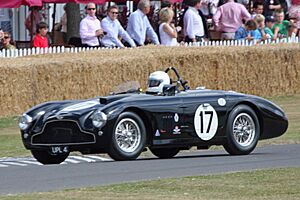 |
Sports Car |
| 1953 | Aston Martin DB3S |  |
Sports Car |
| 1956 | Aston Martin DBR1 | 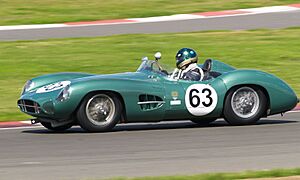 |
Sports Car |
| 1957 | Aston Martin DBR2 |  |
Sports Car |
| 1958 | Aston Martin DBR3 |  |
Sports Car |
| 1959 | Aston Martin DBR4 |  |
Formula One |
| 1960 | Aston Martin DBR5 | Formula One | |
| 1962 | Aston Martin DP212 | 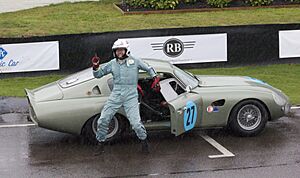 |
Sports Car |
| 1963 | Aston Martin DP214 | 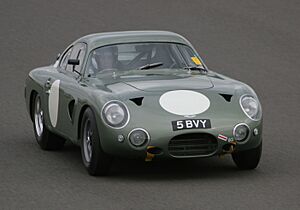 |
Sports Car |
| Aston Martin DP215 | 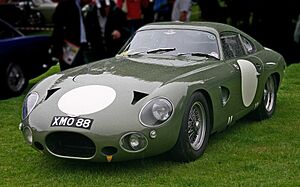 |
Sports Car | |
| 1974 | Aston Martin RHAM/1 |  |
Group 5 |
| 1982 | Aston Martin DPLM | 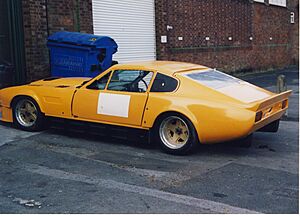 |
Sports Car |
| Nimrod NRA/C2 | 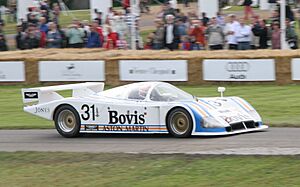 |
Group C | |
| 1983 | EMKA Aston Martin | 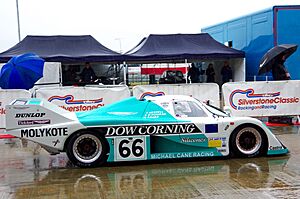 |
Group C |
| Nimrod NRA/C2B |  |
Group C | |
| 1989 | Aston Martin AMR1 |  |
Group C1 |
| 2006 | Aston Martin DBRS9 | 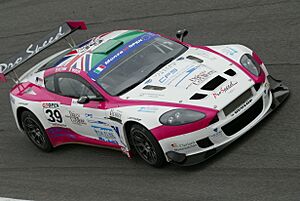 |
Group GT3 |
| Aston Martin Vantage N24 |  |
SRO GT4 | |
| Aston Martin Vantage V8 R-GT |  |
Group R-GT | |
| 2008 | Aston Martin V8 Vantage GT2 |  |
LM GTE |
| Aston Martin V8 Vantage GT4 | 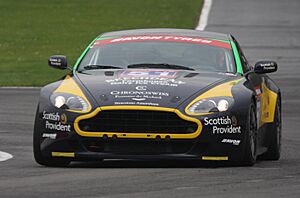 |
SRO GT4 | |
| 2009 | Aston Martin DBR1-2 |  |
LMP1 |
| Aston Martin DBR9 | 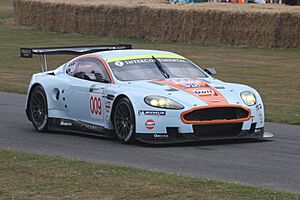 |
Group GT | |
| 2010 | Aston Martin DBR9 |  |
LMP1 |
| Aston Martin DBR9 |  |
Group GT | |
| 2011 | Aston Martin AMR-One | 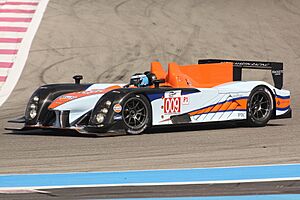 |
LMP1 |
| 2012 | Aston Martin V8 Vantage GTE |  |
LM GTE |
| Aston Martin V12 Vantage GT3 | 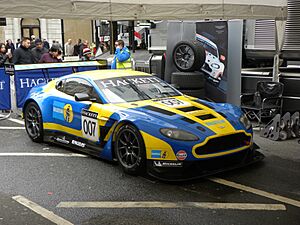 |
Group GT3 | |
| 2018 | Aston Martin V8 Vantage AMR GTE | 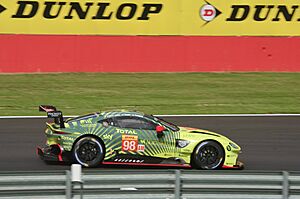 |
LM GTE |
| 2019 | Aston Martin Vantage DTM |  |
Class 1 |
| Aston Martin Vantage AMR GT3 |  |
Group GT3 | |
| Aston Martin Vantage AMR GT4 |  |
SRO GT4 | |
| 2021 | Aston Martin AMR21 | 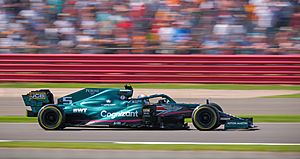 |
Formula One |
| 2022 | Aston Martin AMR22 | 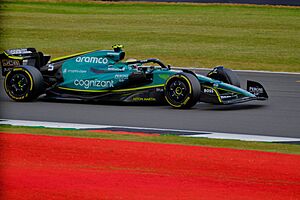 |
Formula One |
| 2023 | Aston Martin AMR23 |  |
Formula One |
| 2024 | Aston Martin AMR24 |  |
Formula One |
| Aston Martin V8 Vantage AMR GT4 (AM6) |  |
SRO GT4 | |
| 2025 | Aston Martin AMR25 | 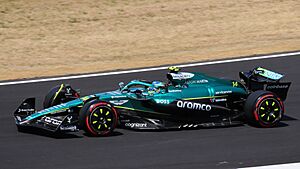 |
Formula One |
| Aston Martin Valkyrie AMR-LMH |  |
LMH |
24 Hours of Le Mans Race Results
| Year | Pos | Class | No | Team | Drivers | Chassis | Engine | Laps |
|---|---|---|---|---|---|---|---|---|
| 1931 | 5 | 1.5 | 25 | Aston Martin 1½-litre International | Aston Martin 1.5L I4 | 139 | ||
| 1932 | 5 | 1.5 | 20 | Aston Martin 1½-litre Le Mans | Aston Martin 1.5L I4 | 174 | ||
| 7 | 1.5 | 21 | Aston Martin 1½-litre Le Mans | Aston Martin 1.5L I4 | 168 | |||
| 1933 | 5 | 1.5 | 25 | Aston Martin 1½-litre Le Mans | Aston Martin 1.5L I4 | 188 | ||
| 7 | 1.5 | 24 | Aston Martin 1½-litre Le Mans | Aston Martin 1.5L I4 | 174 | |||
| 1934 | 10 | 1.5 | 20 | Aston Martin 1½-litre Le Mans | Aston Martin 1.5L I4 | 188 | ||
| 11 | 1.5 | 24 | Aston Martin 1½-litre Le Mans | Aston Martin 1.5L I4 | 180 | |||
| 1935 | 3 | 1.5 | 29 | Aston Martin 1½-litre Ulster | Aston Martin 1.5L I4 | 215 | ||
| 8 | 1.5 | 33 | Aston Martin 1½-litre Ulster | Aston Martin 1.5L I4 | 202 | |||
| 10 | 1.5 | 32 | Aston Martin 1½-litre Ulster | Aston Martin 1.5L I4 | 199 | |||
| 11 | 1.5 | 31 | Aston Martin 1½-litre Ulster | Aston Martin 1.5L I4 | 199 | |||
| 12 | 1.5 | 27 | Aston Martin 1½-litre | Aston Martin 1.5L I4 | 196 | |||
| 15 | 1.5 | 30 | Aston Martin 1½-litre Ulster | Aston Martin 1.5L I4 | 190 | |||
| 1937 | 5 | 1.5 | 37 | Aston Martin 1½-litre Ulster | Aston Martin 1.5L I4 | 205 | ||
| 11 | 2.0 | 31 | Aston Martin Speed Model | Aston Martin 2.0L I4 | 193 | |||
| 1939 | 12 | 2.0 | 29 | Aston Martin Speed Model | Aston Martin 2.0L I4 | 199 | ||
| 1949 | 7 | S 2.0 |
27 | Aston Martin 2-Litre Sports (DB1) | Aston Martin 2.0L I4 | 207 | ||
| 11 | S 2.0 |
29 | Aston Martin 2-Litre Sports (DB1) | Aston Martin 2.0L I4 | 193 | |||
| 1950 | 5 | S 3.0 |
19 | Aston Martin DB2 | Aston Martin 2.6L I6 | 249 | ||
| 6 | S 3.0 |
21 | Aston Martin DB2 | Aston Martin 2.6L I6 | 244 | |||
| 1951 | 3 | S 3.0 |
26 | Aston Martin DB2 | Aston Martin 2.6L I6 | 257 | ||
| 5 | S 3.0 |
25 | Aston Martin DB2 | Aston Martin 2.6L I6 | 255 | |||
| 7 | S 3.0 |
24 | Aston Martin DB2 | Aston Martin 2.6L I6 | 252 | |||
| 10 | S 3.0 |
28 | Aston Martin DB2 | Aston Martin 2.6L I6 | 236 | |||
| 13 | S 3.0 |
27 | Aston Martin DB2 | Aston Martin 2.6L I6 | 233 | |||
| 1952 | 7 | S 3.0 |
32 | Aston Martin DB2 | Aston Martin 2.6L I6 | 248 | ||
| 1955 | 2 | S 3.0 |
23 | Aston Martin DB3S | Aston Martin 2.9L I6 | 302 | ||
| 1956 | 2 | S 3.0 |
8 | Aston Martin DB3S | Aston Martin 2.9L I6 | 299 | ||
| 1957 | 11 | S 3000 |
21 | Aston Martin DB3S | Aston Martin 3.0L I6 | 272 | ||
| 1958 | 2 | S 3000 |
5 | Aston Martin DB3S | Aston Martin 3.0L I6 | 293 | ||
| 1959 | 1 | S 3.0 |
5 | Aston Martin DBR1/300 | Aston Martin 3.0L I6 | 323 | ||
| 2 | S 3.0 |
6 | Aston Martin DBR1/300 | Aston Martin 3.0L I6 | 322 | |||
| 1960 | 3 | S 3.0 |
7 | Aston Martin DBR1/300 | Aston Martin 3.0L I6 | 306 | ||
| 9 | S 3.0 |
8 | Aston Martin DBR1/300 | Aston Martin 3.0L I6 | 281 | |||
| 1977 | 17 | GTP | 83 | Aston Martin DBS V8 RHAM/1 | Aston Martin 5.3L V8 | 260 | ||
| 1982 | 7 | C | 32 | Nimrod NRA/C2 | Aston Martin-Tickford DP1229 5.3L V8 | 317 | ||
| 1983 | 17 | C | 41 | EMKA C83/1 | Aston Martin-Tickford 5.3L V8 | 275 | ||
| 1985 | 11 | C1 | 66 | EMKA C84/1 | Aston Martin-Tickford 5.3L V8 | 338 | ||
| 1989 | 11 | C1 | 18 | Aston Martin AMR1 | Aston Martin (Callaway) RDP87 6.0L V8 | 340 | ||
| 2005 | 9 | GT1 | 59 | Aston Martin DBR9 | Aston Martin 6.0L V12 | 333 | ||
| 2006 | 6 | GT1 | 007 | Aston Martin DBR9 | Aston Martin 6.0L V12 | 350 | ||
| 9 | GT1 | 62 | Aston Martin DBR9 | Aston Martin 6.0L V12 | 343 | |||
| 10 | GT1 | 009 | Aston Martin DBR9 | Aston Martin 6.0L V12 | 342 | |||
| 2007 | 1 | GT1 | 009 | Aston Martin DBR9 | Aston Martin 6.0L V12 | 343 | ||
| 3 | GT1 | 008 | Aston Martin DBR9 | Aston Martin 6.0L V12 | 341 | |||
| 4 | GT1 | 007 | Aston Martin DBR9 | Aston Martin 6.0L V12 | 337 | |||
| 2008 | 1 | GT1 | 009 | Aston Martin DBR9 | Aston Martin 6.0L V12 | 344 | ||
| 4 | GT1 | 007 | Aston Martin DBR9 | Aston Martin 6.0L V12 | 339 | |||
| 2009 | 4 | LMP1 | 007 | Lola-Aston Martin B09/60 | Aston Martin 6.0L V12 | 373 | ||
| 13 | LMP1 | 008 | Lola-Aston Martin B09/60 | Aston Martin 6.0L V12 | 342 | |||
| 3 | GT1 | 66 | Aston Martin DBR9 | Aston Martin 6.0L V12 | 294 | |||
| 2010 | 6 | LMP1 | 007 | Lola-Aston Martin B09/60 | Aston Martin 6.0L V12 | 365 | ||
| 3 | GT1 | 52 | Aston Martin DBR9 | Aston Martin 6.0L V12 | 311 | |||
| 2011 | 7 | LMP1 | 22 | Lola-Aston Martin B09/60 | Aston Martin 6.0L V12 | 328 | ||
| 2012 | 3 | GTE-Pro | 97 | Aston Martin V8 Vantage GTE | Aston Martin 4.5L V8 | 332 | ||
| 2013 | 3 | GTE-Pro | 97 | Aston Martin V8 Vantage GTE | Aston Martin 4.5L V8 | 314 | ||
| 6 | GTE-Am | 96 | Aston Martin V8 Vantage GTE | Aston Martin 4.5L V8 | 301 |
Sponsorships
Aston Martin sponsors the German football club 1860 Munich.
See also
 In Spanish: Aston Martin para niños
In Spanish: Aston Martin para niños
- Aston Martin Heritage Trust Museum
- Aston Martin Owners Club
- List of car manufacturers of the United Kingdom


